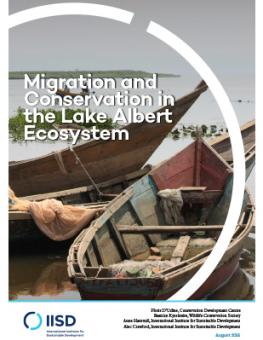
Migration and Conservation in the Lake Albert Ecosystem
Migration is playing a significant role in the deterioration of the Lake Albert ecosystem in Buliisa District, as migrants, mainly coming from neighbouring provinces in the Democratic Republic of Congo, are pulled to the region by the economic opportunities.
Migration is playing a significant role in the deterioration of the Lake Albert ecosystem in Buliisa District. Migrants, mainly coming from neighbouring provinces in the Democratic Republic of Congo, are pulled to the region by the economic opportunities presented by the fishery, and are willing to work for wages lower than those demanded by the local population.
Expanding access to new markets, made possible by infrastructure investments linked to oil and gas exploration, have similarly increased demand for fish from buyers as far away as Kampala. These two forces—increasing demand for fish and increasing supply of labour—have resulted in a fishery dangerously close to collapse: larger species of fish are increasingly rare, while the fish caught are of increasingly smaller size across species. While the implications of this for local livelihoods are significant, current political incentives are aligned with maintaining the status quo. The fishery will continue to deteriorate unless effective and sustainable resource management systems are put in place and migration impacts are addressed.
This report presents an assessment of the migration context in the Lake Albert ecosystem, as well as suggested response strategies. IISD, the Conservation Development Centre and the Wildlife Conservation Society conducted the research with the generous support of the MacArthur Foundation. The research is part of the Migration and Conservation in the Great Lakes Region project, which attempts to address migration and conservation issues by: (a) developing a methodology to better understand the drivers and impacts of migration on critical natural resources, ecosystems and livelihoods in the Great Lakes region; (b) identifying effective responses for policy-makers and practitioners working on these issues; and (c) catalyzing further research and policy engagement on the topic in the region.
You might also be interested in
Migration and Conservation in the Lake Albert Ecosystem (Policy Brief)
Migration is playing a significant role in the deterioration of the Lake Albert ecosystem in Buliisa District, as migrants, mainly coming from neighbouring provinces in the Democratic Republic of Congo, are pulled to the region by the economic opportunities.
Migration and Conservation: A toolkit for conservation and development practitioners
This toolkit helps conservation practitioners assess the impacts of human migration on critical ecosystems.